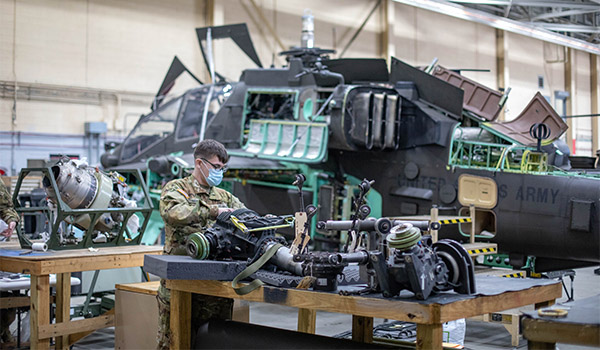
By CSM James D. Wilson: The first 90 days in position have passed quickly. The more I learn, the more amazed I am by what Aviation Soldiers are doing every day to meet demanding mission requirements across the Branch and around the world. The dedication to mission success and taking care of our Soldiers and their families is apparent in every engagement I have with the Soldiers of our Branch.

SPC Lloyd Mayes with D Troop, 1st Squadron, 17th Cavalry, 82nd Combat Aviation Brigade, conducts the disassembly of an AH-64E tail rotor gearbox during a 500-hour phase inspection.
SPC Lloyd Mayes with D Troop, 1st Squadron, 17th Cavalry, 82nd Combat Aviation Brigade, conducts the disassembly of an AH-64E tail rotor gearbox during a 500-hour phase inspection./ army.mil
The future of Army Aviation maintenance and structure are the primary subject for this article. I routinely receive questions from our Soldiers and leaders on the topics I will cover. Many of these topics are not new but remain a top priority as we continue to develop the capabilities of Army Aviation to fight and win in a Multi-Domain Operating Environment.
The Aviation Maintenance Training Program (AMTP) (TC 3-07.71) is one of my top priorities. Our Maintainers have always done an incredible job of conducting and tracking Aviation maintenance. We have multiple systems to track aircraft maintenance and parts down to every subcomponent of the airframe. We can track the entire training record for our Non-Rated Crewmembers (NRCM). We have historically needed a way to track the training, progression, and proficiency of the Soldiers conducting the maintenance. The AMTP solves this issue and is foundational to producing trained and proficient maintenance professionals.
Automating the AMTP to gain efficiency in data input and tracking is also a priority. We are currently working on multiple courses of action to improve the current system required to document and track maintenance training and progression. We must capture maintenance actions as they are input in the Aircraft Notebook (ACN) and migrate that data to a more intuitive interface for Leaders. Eliminating multiple steps and databases to document maintenance training actions will give Soldiers more time on the aircraft, and give leaders more time to schedule, manage and most importantly, train our Soldiers.
The Army Aviation Badge is another area we are looking to make changes. One of the National Commission on Military Aviation Safety (NCMAS) recommendations is to explore Aviation maintenance proficiency badges to recognize and reward proficiency. We are currently discussing the possibility of creating a Basic Aviation Maintainer’s Badge that will be awarded when the Soldier progresses in their unit to Maintenance Level (ML) 1 according to the AMTP. The Senior Maintainer Badge will be awarded when the Soldier has progressed to ML3, and the Master Maintainer badge will be awarded when a Soldier has progressed to ML4. Bottom line, the Maintainers Badge will be linked to skill and proficiency, not just time in the MOS. The current badge will become the Air Crewmember Badge and will be awarded to Non-rated crewmembers starting at Readiness Level 1. This badge will also be tied to skill level, proficiency, and possibly fight hours. Developing an Aviation Maintenance Badge is a large step in our endeavor to professionalize the Army Aviation Maintainer and continue to provide unmatched maintenance capability.
Are we going to consolidate Military Occupational Specialties (MOS) in the future? I have been asked this question multiple times by Soldiers across the Branch. The Organization and Personnel Force Development Directorate (OPFD) at Fort Rucker is currently researching and developing courses of action to address the evolving operating environment in which Aviation maintainers may need broader, multi-functional skill sets to meet the demands of large-scale combat operations. The future environment will drive us to operate in dispersed teams spread over wider areas with the capability to move quickly, which will drive change in how Army Aviation is manned, trained, and equipped. The Future Vertical Lift platforms, when combined with the enduring fleet, will present maintenance and sustainment challenges that need to be addressed in future force design. If we are to remain relevant in the future, we must adapt and become what our Army and Nation needs us to be. I am confident that our Soldiers are up to the challenge.
In closing, I can’t say enough how proud I am to serve as the Aviation Branch Command Sergeant Major. The demand for Army Aviation remains high, and our teams continue to meet and exceed expectations under demanding conditions.
Above The Best!
CSM James D. Wilson is the command sergeant major of the Aviation Branch at the United States Army Aviation Center of Excellence, Fort Rucker, AL.








